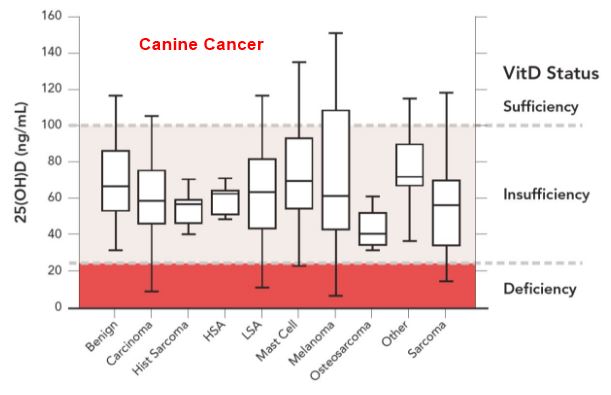Dogs with Cancer have low vitamin D, same as humans
Influence of Various Factors on Circulating 25(OH) Vitamin D Concentrations in Dogs with Cancer and Healthy Dogs.
J Vet Intern Med. 2017 Sep 23. doi: 10.1111/jvim.14834. [Epub ahead of print]
Weidner N1, Woods JP1, Conlon P2, Meckling KA3, Atkinson JL4, Bayle J5, Makowski AJ6, Horst RL6, Verbrugghe A1.
📄 Download the PDF from Vitamin D Life

BACKGROUND:
Low blood 25-hydroxyvitamin D (25(OH)D) concentrations have been associated with cancer in dogs. Little research has examined what other factors may affect 25(OH)D concentrations.
OBJECTIVES:
(1) To determine whether the presence of cancer (lymphoma, osteosarcoma, or mast cell tumor [MCT]) in dogs is associated with plasma 25(OH)D concentrations and (2) identify other factors related to plasma 25(OH)D concentrations in dogs.
ANIMALS:
Dogs newly diagnosed with osteosarcoma (n = 21), lymphoma (n = 27), and MCT (n = 21) presented to a tertiary referral oncology center, and healthy, client-owned dogs (n = 23).
METHODS:
An observational study design was used. Dietary vitamin D intake, sex, age, body condition score (BCS), muscle condition score (MCS), and plasma concentrations of 25(OH)D, 24,25-dihydroxyvitamin D (24,25(OH)2 D) (a marker of CYP24A1 activity), as well as ionized calcium (ICa), parathyroid hormone, and parathyroid hormone-related protein concentrations were measured. An analysis of covariance was used to model plasma 25(OH)D concentrations.
RESULTS:
Cancer type (P = 0.004), plasma 24,25(OH)2 D concentrations (P < 0.001), and plasma ICa concentrations (P = 0.047) had significant effects on plasma 25(OH)D concentrations. Effects of age, sex, body weight, BCS, MCS, and plasma PTH concentrations were not identified. A significant interaction between ICa and cancer was found (P = 0.005). Plasma 25(OH)D concentrations increased as ICa concentrations increased in dogs with cancer, whereas plasma 25(OH)D concentrations decreased as ICa concentrations increased in healthy dogs.
CONCLUSIONS AND CLINICAL IMPORTANCE:
Results support a relationship between cancer and altered vitamin D metabolism in dogs, mediated by plasma ICa concentrations. The CYP24A1 activity and plasma ICa should be measured in studies examining plasma 25(OH)D concentrations in dogs.
